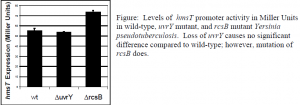Jeffrey Schachterle and Dr. David Erickson, Molecular and Microbiology
Introduction
The bacteria Yersinia pestis is the causative agent of bubonic plague, and its ability to form biofilm in fleas is essential for plague transmission by fleas [1]. Y. pestis recently evolved from Y. pseudotuberculosis (Y. pstb), and the two have nearly identical genomes. Y. pestis forms a biofilm in fleas that is capable of blocking the flea’s feeding. These biofilms are made up of bacteria stuck to a polysaccharide matrix that is made by the hmsHFRS gene products. Y. pstb is capable of infecting fleas, but will block the flea’s feeding [1]. Since the hmsHFRS genes themselves are identical, this suggests that Y. pstb has regulatory elements that function differently from those of Y. pestis. Since these two bacteria likely differ in regulation only, understanding the manner in which biofilm is regulated in Y. pstb will aid in understanding the regulation of biofilm in Y. pestis and the manner in which they have evolved the ability to be transmitted through fleas.
The Erickson lab has previously shown that the BarA/UvrY two-component system impacts biofilm production in Y. pstb. Although it has been shown that they are connected, it remains to be shown how they are connected biologically. Because of previous findings [2], we hypothesized that this two-component system regulates the hmsHFRS genes indirectly through HmsT, an enzyme that produces a small signaling molecule, cyclic-di-GMP. We found that this hypothesis is incorrect by measuring transcriptional levels of hmsT. We also attempted to knock-out the hmsHFRS genes in Y. pstb, however we have been unable to confirm the success of these knockouts.
Materials and Methods
In order to measure the transcriptional levels of hmsT, I generated a reporter fusion using the hmsT promoter with beta-galactosidase as the reporter gene. Briefly, tis was accomplished by amplifying the hmsT promoter region using targeted primers with restriction sites. This was subsequently used in a sticky-end cloning reaction to put the hmsT promoter region into plasmid pJG263 directly upstream of the beta-galactosidase reporter gene. This plasmid was transformed into Y. pstb strains by electroporation. To generate the hmsHFRS knockout, the 500 base pairs (bp) upstream of hmsH and 500 bp downstream of hmsS were cloned together into the vector pMRS101, which was then converted into a pKNG101 derived suicide vector. Y. pstb strains were transformed via conjugation to an SM10 (lambda-pir+) strain of E. coli. Confirmation of the conjugation and desired recombination event was conducted by amplifying a region of the suicide vector with vector specific primers.
Results
When I measured the levels of hmsT promoter activity, I found there was no significant difference between the wild-type Y. pstb and Y. pstb with a non-functional uvrY. However, there was a significant increase in hmsT promoter activity in a Y. pstb strain with a non-functional rcsB. The rcsB mutant consistently showed an increase of about 20 Miller Units relative to the wild-type strain of Y. pstb.
The attempts to knock out the hmsHFRS genes in Y. pstb have thus far not been confirmed. While I have generated candidate bacterial colonies which may be lacking functional hmsHFRS genes, I have been unable to confirm this result due to a lack of amplification in PCR reactions when using the vector specific primers. While as of yet unconfirmed, the candidate colonies show no morphological difference as compared to the parent strains when grown on agar plates containing Congo Red dye. That is, the wild-type bacteria had the same morphology as the candidate hmsHFRS wild-type bacteria.
Discussion
I initially intended to measure the hmsT promoter activity in wild-type and the uvrY mutant Y. pstb. Owing to the fact that I found no significant difference between the wild-type and the uvrY mutants, I decided to check my assay to make sure the result was not due to human error. This check was conducted by measuring the hmsT promoter activity in an rcsB mutant, which has previously been shown to affect transcription of hmsT [2]. The finding that the rcsB mutation does make a difference in hmsT promoter activity in our assay confirms that the similarity in activity between the wild-type and the uvrY mutant are because uvrY does not impact hmsT at the transcriptional level.
Unfortunately, the candidate hmsHFRS mutant colonies have not been confirmed. This is could be explained by one of a few possibilities. First, that the conjugations and interruption of the hmsHFRS genes was unsuccessful, and that I have been unable to confirm the knock-outs because the hmsHFRS genes have not been knocked out. The other possibility is that the primers specific to the suicide vector are not very efficient, leading to low levels of amplification which are below detection.
Conclusion
In conclusion, the results of this project show that contrary to the hypothesis, the BarA/UvrY two-component system does not seem to regulate biofilm formation by regulating hmsT, at least not at the transcriptional level. However, RcsB does seem to regulate biofilm through hmsT, which suggests that the BarA/UvrY two-component system regulates biofilm independent of RcsB. Whether these biofilms are dependent on the hmsHFRS genes is still unknown at this point, however, and will remain so until the hmsHFRS genes can be knocked out to observe whether the biofilms still form.
References
- Erickson DE, et al. 2006. Serotype Differences and Lack of Biofilm Formation Characterize Yersinia pseudotuberculosis Infection of the Xenopsylla cheopis Flea Vector of Yersinia pestis. J Bacteriol. 188(3): 1113–1119.
- Sun YC, et al. 2011. Differential control of Yersinia pestis biofilm formation in vitro and in the flea vector by two c-di-GMP diguanylate cyclases. PLoS One 6:e19267.

